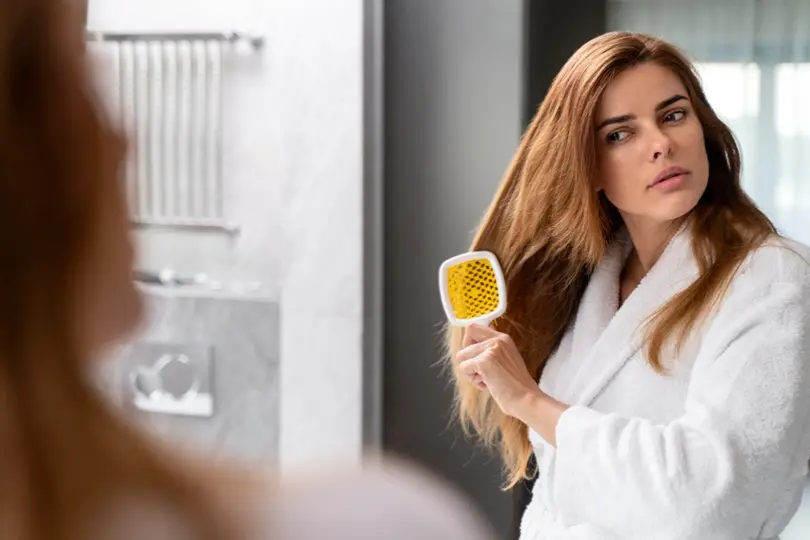
A gentle approach to heated styling supports long-term hair health. Proper preparation and consistent maintenance build resilience against high temperatures. Simple habits support strong shafts and smooth cuticles while keeping moisture locked inside each strand. Guided steps present clear actions that prevent split ends and brittleness. Reliable methods show ways to maintain vibrant locks and healthy texture without complex routines.
1. Applying a Heat Protectant Spray
A heat protectant spray forms a barrier that shields the hair surface so that there is no direct contact with the heat. Balanced spraying on wet or dry hair strands gives every part of the hair uniform protection. Components of the formula can smooth the cuticle and seal in moisture, minimizing the chances of snappiness whilst under a heating device. Usually, a light mist is used to apply the product, which doesn’t leave any residue or bog down hair. The protective layer will simply stick to each hair strand if you let the spray stay on the hair for around five seconds before styling. Basic use of a spray supports safe styling with curling wands or flat irons. Regular application before every heated session builds a consistent defense against temperature stress.
2. Choosing Lower Temperature Settings
Selecting a lower heat setting on a styling device helps maintain natural strength and flexibility within the hair shaft. Many flat irons and dryers offer adjustable controls that range from gentle warmth to high heat levels. Starting at a mid‑range setting simply balances styling speed with strand safety. Lower temperatures usually reduce the chance of cuticle cracks and moisture loss. Patience during styling gives devices time to shape hair gradually, keeping the hair surface intact. Understanding the hair’s tolerance supports choosing the right setting for the desired look. Gentle heat over multiple passes can achieve smooth styles without resorting to extreme temperatures. Smart control of heat levels preserves healthy shine and texture.
3. Limiting Direct Heat Exposure

Reducing the time each section spends under a heated device lowers the chance of damage and dryness. Working in small sections allows even styling without lingering too long on any strand. Using basic hair styling tools from a reputable supplier like Tyme helps guide the device smoothly along the hair, reducing pull and friction. Brief, steady movement across each part ensures controlled heat application. Moving steadily avoids hot spots that can overheat localized areas. Consistent motion combines with product protection to maintain strand integrity. Simple techniques that limit direct exposure keep hair resilient and minimize the risk of breakage or frizz. Controlled styling habits support lasting health and prevent heat stress.
4. Air Drying Before Hot Styling
Allowing hair to air dry until it reaches a slightly damp state reduces the work demanded of heated devices. Damp strands hold heat protection products better than dripping‑wet hair. The process of air drying merely takes time, rather than a blow dryer, to dry the excess moisture and does not remove natural oils. Drying out the water can be approached by definitely squeezing out the water using a delicate towel to accelerate the drying. When the hair is evenly damp, the heat energy is used for styling, not to evaporate. This approach lessens the total heat needed to shape hair and keeps follicles healthy. Balancing air drying with minimal blow‑dry use maintains moisture balance and lowers styling stress.
5. Using Regular Moisture Treatments
Deep conditioning treatments saturate the hair shaft to the root as well as the tip of the hair and reinforce internal protein micro-structure. Hydration is regained by regularly applying thick creams or masks once a week to compensate for heat loss. Such components as natural oils and proteins form a moisture-restoring barrier that heals dry cuticles. By leaving treatments on the recommended time, their absorption and repair are complete. Complete rinsing after this avoids the buildup of the products, which may eventually dull the hair. The frequent application of moisture treatments to the hair creates strength and maintains the strands soft in the face of heat styling habits. Regular treatment facilitates elasticity and minimizes the likelihood of split ends and breakage over time. When the hair is healthy and hydrated, it is more responsive to temperature styling, and it does not lose its shine.
Conclusion
When utilizing heated devices, hair health is maintained by careful style techniques, regulated heat settings, and regular use of protective sprays. Natural strength and moisture balance may be preserved with easy measures like air drying and reducing exposure duration. For long-lasting resilience, regular moisture treatments strengthen and restore strands. Clear practices that focus on gentle care create a foundation for safe styling and vibrant hair texture. Continuous attention to protection and hydration ensures hair remains strong and smooth.
Photo Credit:
Photo 1, Credit to Freepik || Photo 2, Credit to Freepik (CC0 1.0)
Sources:
https://www.haircode.uk/knowledge-base/hair-health-and-science/5-tips-to-prevent-hair-damage
https://odelebeauty.com/blogs/the-rinse/how-to-prevent-heat-damage?srsltid=AfmBOordhPC-vQa8I2VeGjSiQNuHORO870XgxoBfTiZRMtpasFyxbwPx
https://www.dove.com/us/en/stories/tips-and-how-to/hair-care-tips-advice/8-tips-to-prevent-heat-damaged-hair.html


